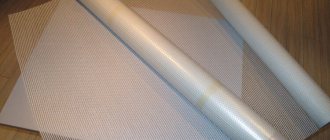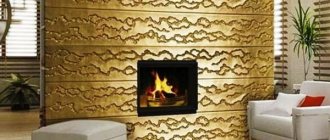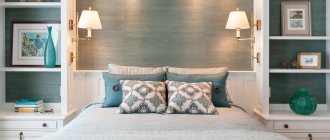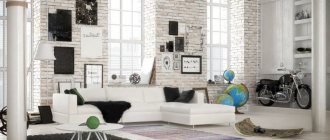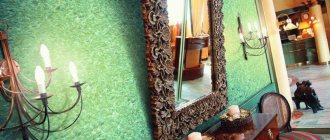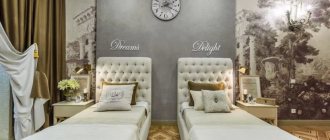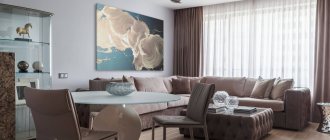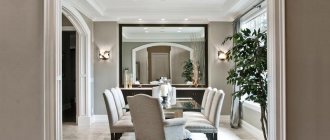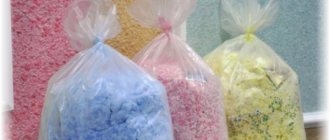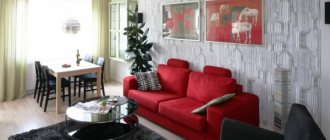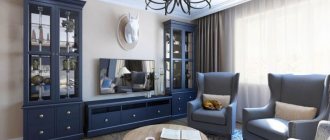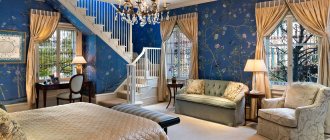Home » Decor » Wallpaper
Wallpaper
Alyona
15991 Views
Every person plans to change the decor and interior of their own home. The solution would be wallpaper for painting in the interior, the selection and painting of which will not take much time. They are selected according to the purpose of the room. It is better to cover living rooms and hallways with a vinyl layer that is resistant to wear, and for bedrooms with less intensive use, paper sheets are suitable. In the nursery and kitchen, where walls can be damaged, the best option is fiberglass types that are resistant to frequent renovations. Everything will be discussed in more detail later in the article.
Advantages of choosing wallpaper for painting
Modern paintable wallpaper will be an excellent and practical choice for every home owner. The obvious advantages of using this finishing material include:
- Ease of interior finishing even without the help of specialists.
- A large selection of possible shades and the possibility of their optimal combination, which allows you to profitably use wallpaper for painting in the interior.
- If you need to change the color scheme of the coating, you can simply apply the next layer of paint.
- All paintable wallpaper produced by modern manufacturers is moisture resistant. In the production of finishing materials today, additional protective coatings are used (most often polymer mixtures play this role), which prevent the formation of dampness, mold, and pathogenic fungus.
- Wallpaper with layers of paint provides additional protection from noise and also helps retain heat in the room.
- In any hardware store, the home owner has the opportunity to choose smooth wallpaper for painting or with a three-dimensional relief.
- A huge selection of original reliefs that give wall panels a voluminous look and interesting decor.
- Before wallpapering, absolutely no preparation of the wall panels is required.
- Thanks to its special strength, wallpaper can be used for a long time, and this, in turn, reduces the financial costs of the owners.
- Volumetric coatings perfectly hide any defects and irregularities. You can evaluate the advantages of such a coating in the photo of wallpaper for painting in the interior.
- Modern production technology involves the use of predominantly natural compounds, which determines the popularity of using such a coating for decorating children's bedrooms.
The best wallpaper for painting fully meets safety requirements, has an optimal cost and a long service life. All known models of wallpaper for painting are produced in light colors, which allows you to apply any shades of paint to the surface, create the brightest color compositions, and decorate walls with stencil designs.
All the pros and cons of wallpaper for painting can be appreciated by every craftsman, designer or apartment owner after renovation.
Photos of glass wallpaper in the interior
Sources
- https://desmyhome.ru/oboi/steklooboi-chto-jeto-takoe-i-kak-s-nimi-rabotat/
- https://design-homes.ru/idei-dlya-doma/steklooboi
- https://rcycle.net/steklo/steklooboi-pod-pokrasku-i-tsvetnye
- https://stroitelstvo.expert/steklooboi/
- https://m-strana.ru/design/steklooboi-v-interere/
- https://ratingstroy.ru/stroitelnye-materialy/napolnye-i-stenovye-materialy/steklooboi-ih-vidy-harakteristiki-i-naznachenie/
- https://TvoiDvor.com/oboi/kak-kleit-steklooboi/
- https://Trizio.ru/steklooboi-v-interere-212
- https://couo.ru/kvartira-i-zagorodnyj-dom/stroitelstvo-i-remont/chto-takoe-steklooboi-i-gde-ix-mozhno-ispolzovat.html
Disadvantages of choosing wallpaper for painting
There are not many disadvantages of this choice:
- High cost per roll. Renovating a large apartment or private house will require significant financial investments.
- Some rolls, for example with fiberglass, are more than 1 meter wide. In such situations, it is quite difficult to carry out repairs yourself.
Paintable paper wallpaper is significantly limited in the frequency of paint application and decorative spraying, and then requires a complete change of the canvas.
What paint should I use?
The type of wallpaper dictates what paint should be applied. Water-based emulsion paint is suitable for non-woven and paper-based wallpaper. Acrylic with its moisture-resistant properties is also suitable for non-woven and glass wallpaper.
In addition to acrylic, latex is suitable for glass wallpaper. When choosing paint, pay attention to drying speed and toxicity.
Optimal selection criteria
Making a choice between wallpaper for painting or simply painting wall panels is difficult, and therefore it is better to use the following criteria:
- Determine the size of the premises to be finished.
- The color of the wallpaper is important, because some manufacturers produce not only white and cream materials, but also bright coverings with ready-made prints.
- Calculate the amount of financial investments for both options.
- Discuss the possibility of carrying out repair work yourself, because the help of a finishing specialist can cost a pretty penny.
- The next step is to choose a quality manufacturer. In this case, the owners of an apartment or private house will have to read reviews about wallpaper for painting and carefully weigh all the advantages and disadvantages. Paintable wallpaper from the Marburg company received a lot of positive feedback.
The frequency of changing the paint coating is limited for embossed wallpaper, and is determined by the depth of the embossing on the surface. For this reason, the approximate service life of the decorative canvas and the expected frequency of subsequent painting should be determined in advance.
Features of using wallpaper for painting
No special preparation of walls is required for wallpapering. However, a number of general measures still need to be completed. How to glue wallpaper for painting:
- All walls are thoroughly cleaned of old coating.
- It is better to seal holes and large cracks with putty - this will allow you to retain maximum heat in the room, avoid drafts and dampness.
- Be sure to remove all sockets, switches, and keys.
- Before applying the decorative fabric, it is better to check the condition of the electrical wiring and other communications so that in the future you do not have to urgently remove the new coating.
- When carrying out repairs yourself, you should remember that the width of a roll of wallpaper for painting is larger than standard wallpaper.
- The strip for pasting should be cut with an additional 5-7 cm, the purpose of which is to cover uneven areas and joints between adjacent wallpaper strips.
- Apply the adhesive base to the wallpaper and wait up to 10 minutes for the glue to absorb.
- The first step is to lightly press the upper part of the strip against the wall, and smooth the rest of the strip using a brush or roller. It is important to observe the direction of pressure - from the center to the periphery, so that rough folds do not form.
- To remove excess material, it is better to use a sharp stationery knife (it will not tear the fabric).
- Wallpapering in hard-to-reach places (corners, construction niches, doorways, space under the window sill) deserves special attention. In this case, the wallpaper strips are glued overlapping each other (the width of the neutral strip is 2-3 mm). Begin pasting from the doorway, from above the window sill, to mask the seams.
To paint wallpaper, use a roller, spray or brush. This can be acrylic paint for wallpaper for painting or a water-based composition.
The texture of the decorative coating can be matte, satin or have a glossy surface. The choice in each case depends on the wishes of the apartment owner himself.
Note!
- Glass wallpaper - what is it? Pros and cons, types, features, characteristics, photos of design and combinations in the interior
Plain wallpaper - 150 photos of modern design. Rules for choosing and combining wallpaper in the interior: kitchen, bedroom, living room, hallway
Wallpaper framed on the wall in the interior: photos of original design and beautiful decor
Types of wallpaper for painting
Depending on the base used, the wallpaper catalog includes the following varieties:
- On paper.
- Compositions with fiberglass.
- Non-woven wallpaper for painting.
The list is completed by paintable vinyl wallpaper with two layers (the decisive role is played by the additional layer - paper or non-woven fabric).
Each of the known materials has a number of advantageous qualities or disadvantages, and also requires the use of special glue and decorative paint. It is up to the master to decide which wallpaper to paint, but if you wish, you can turn to a sales consultant for help.
How to glue wallpaper for painting
The glue must completely match the appearance of the wallpaper. The composition for paper will not be able to stick non-woven wallpaper, much less fiberglass wallpaper. The heavier the canvas, the denser the glue composition you need to choose.
When gluing non-woven or fiberglass wallpaper, the glue is applied directly to the wall. Source: https://tg-alterra.ru
Wallpaper is glued only after the fresh finishing of walls and ceilings has been completed. This means that the surface is sanded, puttied and plastered again after removing the old coating or paint from the wall. After finishing the walls, you need to dry them completely, especially in the corners. If this is not done, the wallpaper will not stick.
Pasting begins with preparation. The canvases are cut into strips of the same length, equal to the height of the walls plus a few cm for spare. Paper wallpaper is completely coated with glue so that it is saturated with the composition on both sides. It’s easier with non-woven and glass wallpaper: just apply glue to the wall.
The strips are carefully glued, starting from the window, aligned from top to bottom, gradually pressing the canvas to the surface. It is always necessary to glue at the joint, because even if the overlaps are not immediately visible, the stripes will definitely come out after painting.
If you are going to cover the ceiling, pay attention to wide paper wallpaper. In this case, even with poor lighting, the joints will remain invisible. Wallpaper on the ceiling tends to peel away from the surface, so it is important to choose materials with moisture-resistant impregnation.
Non-woven wallpaper
A very practical option, characterized by sufficient strength and aesthetic appearance. Advantages of using this decorative coating:
- The wallpaper is glued quite easily, but too much pressure can lead to distortion of the relief pattern.
- The coating is very resistant to moisture, accidental fire, and fits perfectly onto the underlying surface. For this reason, preliminary preparation of the walls is not required.
- This material never causes allergic reactions, so it can be used for covering walls in a child’s bedroom, playroom, or in the room of a person with bronchial asthma. The basis of the wallpaper for painting, as well as the outer covering, are made exclusively from natural compounds.
A decorative layer can be applied to textured wallpaper for painting in several ways: by spraying, in the classic way using a roller, using special stencils, or embossing.
Drying time
The drying period of paint on walls depends on many factors:
- porosity of the base - paintwork takes longer to dry on embossed wallpaper;
- temperature in the room - at +20...+27 degrees the paint will dry faster, but if the house is hot, the composition can become very thin;
- humidity – drier air promotes faster drying;
- good ventilation - air circulation (with the exception of drafts) helps dry the walls;
- layer thickness - the thinner the paint is applied, the sooner it will harden;
- type of paint - water-based materials dry quickly.
Most paints dry within 2-24 hours, but should not be recoated within 12 hours. Oil compositions dry for about two days, but they are not used for painting wallpaper.
Wallpaper with fiberglass
Families with children should think about choosing very high-quality materials that will withstand children's games, drawings on the walls, and frequent cleaning by wiping the surface with a damp cloth.
Such modern materials include coatings with fiberglass, which, due to their durability, are called anti-vandal paintable wallpaper. The second advantage of such a coating is the absolute safety of the high-quality composition and the absence of allergic reactions to the components (even the glue used is starch-based).
Glass wallpaper
Durable and wear-resistant. They are made from fiber using fabric or paper with an outer layer of fiberglass applied. The possibility of repainting them reaches thirty times or more! They can be cleaned without stripping the fiber.
Their main advantage is safety: glass wallpaper does not burn. Suitable for public spaces, offices, waiting rooms. When gluing, be careful and careful!
